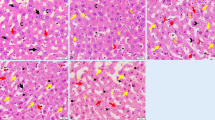Abstract
Natural dyes and especially hematoxylin, which is herbal, are widely used in staining tissues. The aim of this study is to evaluate the staining status of different tissues taken from rats with pomegranate flower extract. For this reason, 2 Wistar albino rats, one male and one female, were used as stain biomaterial. A histological follow up procedure was applied to the lung, kidney, liver, and heart tissue samples taken from the rats and the unstained preparates of these tissues were prepared. As the source of the dye, the dry flowers of Punica granatum (PG) obtained from local markets of Kayseri were used. Each tissue sample underwent the same staining procedure with the same temperature, duration, and dye solution. Before and after the staining procedure, × 40 images of the tissue preparates were taken using a light microscope. Generally, different tones of staining were observed in the nuclei and cytoplasms of all cells and epithelium cells. Staining in parts specific to each tissue occurred. For example, there were light stains on the glomerular cells and the Bowman capsule in the kidney tissue Differences in staining can only be explained by molecular diversity differences in tissue. However, in order to improve the initial staining results obtained in this study, it is possible that working with different temperatures, pH values, mordant substances, and dye that the dye molecules in the extract will provide more vivid colors with different molecules in the tissues.




Similar content being viewed by others
References
Suebkhampet A, Sotthibandhu P (2012) Effect of using aqueous crude extract from butterfly peaflowers (ClıtorıaTernatea L.) as a dye on animal blood smear staining. Suranaree J Sci Technol 19(1):15–19
Lillie RD, Pizzolato P, Donaldson PT (1975) Hematoxylinsubstitues: a survey of mordant dyes tested and consideration of the relation of their structure and performance as nuclear. Stain Technol 5:25–41
Bassey RB, Osinubi AA, Oremosu AA (2012) Staining effect of Hibiscus sabdariffa extract on sperm cell morphology of Sprague-Dawley rats. J Histotechnol 35(3):110–113
Avwioro OG, Onwuka SK, Moody JO, Agbedahunsi JM, Oduola T, Ekpo OE, Oladele AA (2007) Curcuma longa extract as a histological dye for collagen fibres and red blood cells. J Anat 210:600–603
Chigurupati N, Saiki L, Gayser CJ, Dash AK (2002) Evaluation of red cabbage dye as a potential natural color for pharmaceutical use. Int J Pharm 241:293–299
Ephraim P, Lansky A, Robert A, Newman A (2007) Punicagranatum (pomegranate) and its potential for prevention and treatment of inflammation and cancer. J Ethnopharmacol 109:177–206
Batta AK, Rangaswami S (1973) Crystalline chemical components of some vegetable drugs. Phytochemistry 12:214
Huang TH, Harada M, Yang Q, Li GQ, Yamahara J, Roufogalis BD, Li Y (2005) Pomegranate flower extract diminishes cardiac fibrosis in Zucker diabetic fatty rats: modulation of cardiac endothelin-1 and nuclear factor-kappaB pathways. J Cardiovasc Pharmacol 46:856–862
Hernandez F, Melgarejo P, Tomas-Barberan FA, Artes F (1999) Evolution of juice anthocyanins during ripening of new selected pomegranate (Punicagranatum) clones. Eur Food Res Technol 210:39–42
Davulcu A, Benli H, Şen Y, Bahtiyari M (2014) Dyeing of cotton with thyme pomegranate peel. Cellulose 21:4671–4680
Singh R, Srivastava S (2015) Exploration of flower based natural dyes—a review. Res J Recent Sci 4:6–8
Kılıç C, Anatomisi A (2011) J Clin Anal Med. https://doi.org/10.4328/JCAM.964
Sinnatamby CS (2006) Last’s anatomy; regional and applied, 11th edn. Churchill Livingstone, New York, pp 219–224
Johnson D, Shah P (2005) Thorax. In: Standring S (ed) Gray’s anatomy, 39th edn. Churchill Livingstone, Edinburgh, pp 951–1079
Gryspeerdt S, Van Hoe L, Marchal G, Baert AL (1997) Evaluation of hepatic perfusion disorders with double-phase spiral CT. Radiographics 17:337–348
Yano K, Ohtsubo M, Mizota T, Kato H, Hayashida Y, Morita S et al (2000) Riedel’s lobe of the liver evaluated by multiple imaging modalities. Intern Med 39:136–138
Başak M, Akan D (2015) Karaciğerin ve Safra Yollarının Radyolojik Anatomisi. Turk Radiol Semin 3:336–348
Zeidel ML, Hoening MP, Palevsky PM (2014) A new CJASN series: renal physiology for the clinican. Clin J Am Soc Nephrol 9:1271
Guyton AC, Hall JE (2011) Textbook of medical physiology, 11th edn. Saunders Elsevier, Philadelphia
Widmaier EP, Raff H, Strang KT (2010) Vander’s human physiology: the mechanisms of body function. Chapter 12. 12th edn. McGraw-Hill, New York
Doran F (2005) Histokimya. Aegean Pathol J 2:62–70
Author information
Authors and Affiliations
Corresponding authors
Ethics declarations
Conflict of interest
The authors declare that they have no conflict of interest.
Rights and permissions
About this article
Cite this article
Kuşçulu, N.G., Aslan, H.G. Evaluation of an extract of the Punica granatum flower as a biological stain of rat tissues: a preliminary study. Mol Biol Rep 46, 581–585 (2019). https://doi.org/10.1007/s11033-018-4510-3
Received:
Accepted:
Published:
Issue Date:
DOI: https://doi.org/10.1007/s11033-018-4510-3




